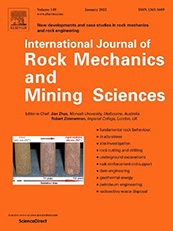Numerical modelling of incipient motion of fracture infillings

Teng, P., Zhang, S. and Johansson, F. (2021) Numerical modelling of incipient motion of fracture infillings. International Journal of Rock Mechanics and Mining Sciences 48 (December 2021); 104960.
doi.org/10.1016/j.ijrmms.2021.104960
Abstract: Fine-grained infilling materials in rock fractures cannot be penetrated by cement-based grout, while high water velocities in the unfilled parts of the fracture can impose erosion of the infilling materials. Understanding the erosion process of the infilling materials is, therefore, essential for the design of grout curtains. In this paper, the incipient motion of infilling particles in a three-dimensional rock fracture is predicted by a coupled Computational Fluid Dynamics (CFD)-Discrete Element Method (DEM) approach. A fracture model is built based on high-resolution optical scanning data of a natural rock joint surface. Infilling particles are modelled as non-cohesive spheric particles in a range of fine-sand sizes. The motion of particles is produced by coupling the CFD, solving the Navier-Stokes equations, with the DEM, prescribing the contact forces between particles. The model could capture the particle-particle and particle-fluid interaction behaviours during particle movement. Simulation results of the fracture model are compared with a parallel-plate model, which shows that the fracture geometry significantly affects the transport and distribution of the infillings. The dimensionless critical shear stress of the fracture model for the studied fracture is 11% larger than the values obtained from the parallel-plate model. Furthermore, the simulations are compared with the Hjulström and Shields diagrams, showing that the use of these two diagrams to predict the infilling erosion in the fracture results in a significant discrepancy. In contrast, a previous equation derived from flume experiments under laminar flows agrees better with the simulations. The present study visualises and quantitatively analyses the erosion process of the fracture infillings, which provides a reference to predict the threshold of the infilling erosion.
